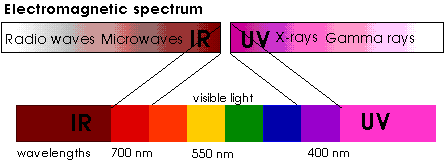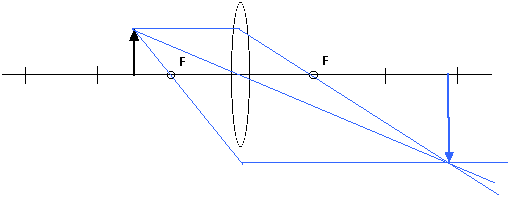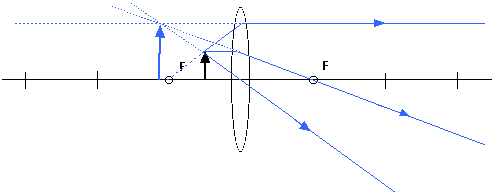

![]()
For every question, also consider as a possible answer
E) none of the above
Possibly useful information:
v = ![]() x
/
x
/ ![]() t
t
![]() p = m v
p = m v
![]() T = 2
T = 2
![]()
![]()
a = ![]() v
/
v
/ ![]() t
t
![]() PE = m g
h
PE = m g
h ![]() T = 2
T = 2
![]()
![]()
v = vi + a t ![]() PE
= (1/2) k x2
PE
= (1/2) k x2 ![]() v
=
v
= ![]()
x = xi + vi t + (1/2)
a t2 ![]() KE
= (1/2) m v2
KE
= (1/2) m v2 ![]() v=(wavelength)
x (frequency)
v=(wavelength)
x (frequency)
v = r ![]()
![]() F = k x
F = k x
![]() L
= (n) x (half wavelength)
L
= (n) x (half wavelength)
F = m a ![]() Ei
= Ef
Ei
= Ef
F12 = - F21 ![]() pi
= pf
pi
= pf
w = mg ![]() F
=
F
= ![]() p
/
p
/ ![]() t
t
g = 9.8 m/s2 ![]() 10 m/s2
10 m/s2
1/f = 1/do + 1/diM = - di/do
M = 25 cm/f
di = [1/n] do
n1 sin ![]() 1
= n 2 sin
1
= n 2 sin ![]() 2
2
M = fobj/feye
c = 3.00 x 108 m/s
For every question, also consider as a possible answer
E) none of the above
e) none of the above
1. Electromagnetic waves consist of
a) compressions and rarefactions of electromagnetic pulses.b) oscillating electric and magnetic fields.
c) particles of light energy.
d) high-frequency gravitational waves.
2. Electromagnetic waves
a) can travel through a vacuum.b) need a medium to travel through.
3. The main difference between a radio wave and a light wave is its
a) speed (both have the same speed, 3.0 x 108 m/s)b) wavelength
(the wavelength for radio waves is measured in meterswhile the wavelength of light is measured in nanometers)
c) EM characteristic (both are EM waves)
d) all of the above
4. Which of these electromagnetic waves has the shortest wavelength?
a) X-raysb) ultraviolet waves
c) infrared waves
d) radio waves

5. Compared to ultraviolet waves, the wavelength of infrared is
a) longerb) identical
c) shorter
6. Compared to radio waves, the velocity of visible light waves in a vacuum is
a) greaterb) the same (all EM waves have the same speed, 3.0 x 108 m/s)
c) less
7. Compared to radio waves, the wavelength of visible light waves in a vacuum is
a) longerb) the same
c) shorter
8. Which of the following is fundamentally different from the others?
a) X-rays (EM wave requiring no medium)b) visible light waves (EM wave requiring no medium)
c) sound waves (sound is a mechanical wave that requires a medium)
d) radio waves (EM wave requiring no medium)
9. The sensation of color is seen when light falls on the eye's
a) rodsb) cones
c) cornea
d) crystalline lens
10. The cones in the retina of the eye are
a) most densely packed at the center of vision, the fovea.b) uniformly spread along the visual field.
c) concentrated along the periphery of vision.
d) concentrated at the "blind spot" where the optic nerve attaches to the retina.
11. If a light signal and a radio signal were emitted simultaneously from Alpha Centauri, the first to reach Earth would be the
a) the radio signalb) the light signal
c) both would arrive at the same time
(all EM waves have the same speed, 3.0 x 108 m/s)
12. Color depends on what characteristic of light?
a) wavelengthb) frequency
c) both of these ( frequency x wavelength = speed )
d) neither of these
13. The colored dots that make up the color on a TV screen are
a) red, yellow, greenb) red, yellow, blue
c) red, green, blue
d) cyan, magenta, yellow
14. Magenta light is a mixture of
a) red and yellowb) cyan and yellow
c) red and blue
d) yellow and blue
15. Colors seen on TV result from color
a) subtractionb) addition
c) neither of these
d) either of these
16. Colors seen on the cover of a magazine result from color
a) subtractionb) addition
c) neither of these
d) either of these
17. Different colors of light correspond to different light
a) velocitiesb) intensities
c) polarities
d) frequencies
18. Look at a full-color picture in a magazine with a magnifying glass and you'll see that the inks used are
a) red, green, cyan, and blue.b) red, green, blue, and black.
c) magenta, cyan, yellow, and black.
d) magenta, cyan, yellow, and blue.
19. A sheet of red paper will look black when illuminated with
a) red lightb) cyan light
c) yellow light
d) magenta light
20. A blue object will appear black when illuminated with
a) blue lightb) yellow light
c) red light
d) cyan light
Ooops! There were TWO correct answers so this question was NOT scored. That means everyone received credit for this question.
21. A mixture of red and green light produces
a) blueb) magenta
c) yellow
d) cyan
22. A spotlight produces white light which then passes through a filter that absorbs the yellow light. What color is the light that passes through?
a) redb) green
c) blue
d) yellow
23. A spotlight produces white light which then passes through a filter that absorbs the red light. What color is the light that passes through?
a) redb) yellow
c) magenta
d) cyan
24. Light travels fastest in
a) waterb) vacuum
c) air
d) glass
25. Refraction, as light goes from air to glass, results from differences in light's
a) frequency in air and glassb) incident angle
c) speed in air and glass
d) all of the above
26. Light refracts when traveling from air into glass because light
a) intensity is greater in air than in glassb) frequency is greater in glass than in air
c) speed is greater in air than in glass
d) polarization is greater in glass than in air
27. A beam of light emerges from water into air at an angle. The beam is bent
a) toward the normalb) away from the normal
c) at an angle of 49°
d) only if it is polarized
28. When a light beam emerges from water into air, the light speed
a) increasesb) remains the same
c) decreases
29. Refraction causes the bottom of a swimming pool to appear
a) farther away than it really isb) closer to the surface than it really is
30. Different colors are dispersed by a prism because different colors in the prism have different
a) speedsb) directions
c) energies
d) momenta
31. The critical angle for a transparent material is the angle at and beyond which all light within the material is totally
a) absorbedb) reflected (total internal reflection)
c) refracted
d) polarized
32. In an optical fiber, light actually
a) curves in a direction parallel to the central axis of the fiber.b) travels in straight-line segments.
(by total internal reflection, light is reflected at the edge of the optic fiber)c) travels along the outer surface of the fiber.
d) all of the above.
33. Your image in a plane mirror is
a) virtualb) real
c) both of these
34. The type of lens that spreads parallel light is a
a) converging lens |
|
35. Which of the following can be projected onto a viewing screen?
a) a virtual imageb) a real image
c) a convex image
d) a concave image
36. The image of something "infinitely far away", like the Sun, produced by a converging lens appears
a) between the lens and the focal pointb) at the focal point
c) between the focal point and twice the focal length
d) at twice the focal length
37. Your vision is sharpest when your pupil is
a) dilated or opened wideb) constricted or made tiny
c) blue
d) brown
38. According to Huygens' principle, every point on a wave
a) is a diffraction source.b) behaves as a source of new waves.
c) is the superposition of every other part of the wave.
d) all of the above.
39. Consider plane waves incident upon a barrier with a small opening. After passing through the opening, the waves
a) continue as plane wavesb) spread out
c) are polarized
d) converge
40. Light will not pass through a pair of Polaroids when their axes are
a) parallelb) rotated 45°
c) rotated 57°
d) perpendicular
41. Monochromatic light is light of a single
a) colorb) wavelength
c) frequency
d) all of the above
42. Light from a laser is
a) monochromaticb) in phase
c) coherent
d) all of the above
43. A 2-m tall person viewing his full-length image in a plane mirror requires a mirror that is at least
a) 0.5 m |
|
44. In the interference pattern produced by shining a laser through two slits (Young's double slit experiment), the bright areas are the result of
a) destructive interference.b) polarization.
c) constructive interference.
d) restructive construction.
45. When light passes through a diffraction grating it is bent. Light with a greater wavelength will be bent
a) through a smaller angle.b) the same (bending is independent of wavelength).
c) through a larger angle.
46. Rainbows are a result of
a) dispersion and reflection.b) dispersion and polarization.
c) reconstruction and polarization.
d) constructive and destructive interference.
47. An object is placed 20 cm from a converging lens that has a focal length of 10 cm. Make a ray diagram of this situation. From the ray diagram, characterize the image.

The image is
a) real and inverted (and the same size)b) virtual, inverted, and smaller.
c) virtual, upright, and smaller.
d) virtual, inverted, and larger.
48. An object is placed 30 cm from a converging lens that has a focal length of 10 cm. Make a ray diagram of this situation. From the ray diagram, characterize the image.

The image is
a) real, inverted, and larger.b) real, inverted, and smaller.
c) virtual, upright, and smaller.
d) virtual, inverted, and smaller.
49. An object is placed 15 cm from a converging lens that has a focal length of 10 cm. Make a ray diagram of this situation. From the ray diagram, characterize the image.

The image is
a) real, inverted, and larger.b) real, inverted, and smaller.
c) real, upright, and smaller.
d) virtual, upright, and larger.
50. An object is placed 5 cm from a converging lens that has a focal length of 10 cm. Make a ray diagram of this situation. From the ray diagram, characterize the image.

The image is
a) real, inverted, and larger.b) real, inverted, and smaller.
c) virtual, upright, and smaller.
d) virtual, upright, and larger.
![]()
(C) 1998 Doug Davis, all rights reserved